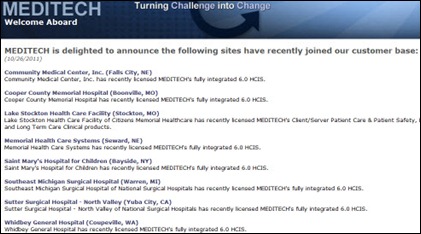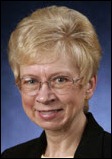Anything related to defense will need to go to Genesis.
News 10/28/11
Top News
Cerner announces Q3 numbers: revenue up 24%, EPS $0.45 vs. $0.36. beating estimates excluding one-time items and raised guidance. The conference call transcript is here. Cerner says customers of an unnamed competitor (Epic) are concerned about their vendor’s ability to keep up with Meaningful Use requirements beyond Stage 1. It also says Epic’s customers are vulnerable to Cerner poaching because of Epic’s deficiencies in ACO readiness, lack of analytics capabilities, and poor total cost of ownership. Recently announced products were mentioned, as was the company’s acquisition of Clairvia and hints that other acquisitions may be forthcoming as “the clock is ticking” in acquisitions starting to look less attractive. It’s also implied that competitors (again, that would have to be Epic) may be getting bottlenecked in their ability to start implementations promptly.
HIStalk Announcements and Requests
![]() This week on HIStalk Practice: daily reports from Las Vegas on MGMA’s annual conference. Mr. H declared I was “full of myself” (harrumph), but you will have to read the updates and make your own assessment. The posts include impressions on various speakers (Dr. Farzad Mostashari and Intel’s Eric Dishman were my favs); assessments of the hottest topics (connectivity, communication tools, and more); the exhibits (nice booths, annoying Elvises, a bit of technology, and the best giveaways); and, of course, hot shoes. Thanks for reading.
This week on HIStalk Practice: daily reports from Las Vegas on MGMA’s annual conference. Mr. H declared I was “full of myself” (harrumph), but you will have to read the updates and make your own assessment. The posts include impressions on various speakers (Dr. Farzad Mostashari and Intel’s Eric Dishman were my favs); assessments of the hottest topics (connectivity, communication tools, and more); the exhibits (nice booths, annoying Elvises, a bit of technology, and the best giveaways); and, of course, hot shoes. Thanks for reading.
![]() Listening: The Black Keys, an Akron-based white nerd duo whose Brothers album sounds like bluesy soul from the early 1960s (but they really rock out on earlier stuff in no-frills ‘70s Ted Nugent fashion). Excellent. And “Not Listening” despite a reader’s calling it to my attention (“Holy Shatner,” he said): yet another hideous and uber-hammy William Shatner non-musical recitation, this time to the tune of Queen’s Bohemian Rhapsody, making his previous masterwork Lucy in the Sky with Diamonds sound like Beethoven by comparison. If you like Star Trek, Queen, music, or your sanity, you’ve been warned because it will bore into your skull like an earwig (entomologically incorrect, I know, but an apt metaphor.) I suppose we can all only dream of being as cornily popular and scorn-immune when we reach Bill’s age (80).
Listening: The Black Keys, an Akron-based white nerd duo whose Brothers album sounds like bluesy soul from the early 1960s (but they really rock out on earlier stuff in no-frills ‘70s Ted Nugent fashion). Excellent. And “Not Listening” despite a reader’s calling it to my attention (“Holy Shatner,” he said): yet another hideous and uber-hammy William Shatner non-musical recitation, this time to the tune of Queen’s Bohemian Rhapsody, making his previous masterwork Lucy in the Sky with Diamonds sound like Beethoven by comparison. If you like Star Trek, Queen, music, or your sanity, you’ve been warned because it will bore into your skull like an earwig (entomologically incorrect, I know, but an apt metaphor.) I suppose we can all only dream of being as cornily popular and scorn-immune when we reach Bill’s age (80).
![]() Jobs on the sponsors-only Job Board: Project Specialist I, Account Manager, RVP Sales – Ohio Valley Territory. On Healthcare IT Jobs: Lab Information Systems Analyst, Regional Sales Executive, Epic Security Analyst, Network Administrator.
Jobs on the sponsors-only Job Board: Project Specialist I, Account Manager, RVP Sales – Ohio Valley Territory. On Healthcare IT Jobs: Lab Information Systems Analyst, Regional Sales Executive, Epic Security Analyst, Network Administrator.
Acquisitions, Funding, Business, and Stock
Perceptive Software increases its Q3 revenues by about 15%, but less than parent company Lexmark says it expected when it acquired the company last year. Perceptive contributed $23 million of Lexmark’s $1.03 billion in quarterly revenues.
UPMC announces Q operating income of $155 million on operating revenue of $2.4 billion. A year ago, operating income was $93 million. The gain includes $36 million for demonstrating Stage 1 Meaningful Use.
McKesson’s earnings call transcript is here. There wasn’t much new about the technology division, other than profit was up 25% excluding an impairment charge. Analysts who asked questions were more interested in Lipitor and flu vaccine.
Healthcare billionaire Patrick Shoon-Shiong’s NantWorks acquires Ziosoft, a Japan-based vendor of supercomputing software that merges data from a variety of medical images (CT, MR, ultrasound) to allow 3D, 4D, and 5D analysis for diagnosis. The company will be renamed Qi Imaging everywhere except in Japan, where it has 2,000 of its imaging workstations installed.
NextGen parent Quality Systems Inc. reports Q2 numbers: revenue up 32%, EPS $0.35 vs. $0.23. A two-for-one share split took effect Thursday.
Sales
Meditech announces eight new clients.
The Virginia Department of Health awards Community Health Alliance a contract for the statewide HIE. CHA’s strategic and technology partners include MEDfx (IT services), MedVirginia (support services), Troutman Sanders (governance), and Verizon (HIE platform.)
The VA gives Harris Corporation a two-year, $5.3 million contract to transition its billing to ICD-10.
Tucson Medical Center selects MethodCare’s Charge Recovery application to improve coding compliance and identify missed charges.
Shamokin Community Area Hospital (PA) selects ProVation MD for gastroenterology documentation and coding.
People
BridgeHead Software appoints Jim Beagle CEO and president. Former CEO and founder Tony Cotterill will serve as executive chairman of the board and as EVP and chief products officer.
Allscripts appoints Catherine Burzik, president and CEO of Kinetic Concepts, to its board of directors.
MGMA and ACMPE name David Bowman, MD Physician Executive of the Year for outstanding leadership to achieve exceptional performance in healthcare delivery. He is executive director of IPC The Hospitalist Company.
HealthTech Holdings, the holding company that owns HMS, MEDHOST, and Sentry Healthcare Services, names Alan MacLamroc CTO and Geoff Roten CIO.
Announcements and Implementations
Houston Healthcare goes live on Meditech on October 31. CIO Robert Rhodes indicates the organization has invested about $6 million to implement the system.
Springfield Service Corporation and its subsidiary Laguna Medical Systems rebrand into a single organization named SPi Healthcare. The company specializes in RCM, health information management, and ASP hosting.
Piedmont Healthcare (GA) partners with TeleHealth Services to implement TeleHealth’s TIGR system for on-demand patient education and interactive communication.
Aetna President Mark T. Bertolini tells investors that its Medicity subsidiary has a $200 million contract revenue backlog and recently launched its iNexx application store. On supporting the ability of consumers to pay for medical services at the point of sale, “We also can now real-time auto-adjudicate a claim on a smart phone at the doctors office, by the consumer or the provider should they choose to do that, because we’ve now been able to create real-time auto-adjudication connection mobilely. The real issue, the ultimate issue here is whether or not people have the incentive to use it. And I think that’s where plan designs and the accountable care organizations and how they link to these platforms — that’s why we bought Medicity, will create people’s ease-of-use in using the system and using this technology to make decisions at the point-of-sale. And that’s ultimately where this needs to head.”
Olympic Medical Center (WA) signs on as an affiliate of Swedish Medical Center, with OMC’s CEO touting as a key benefit its access to Swedish’s Epic system. He said Epic is “the best” EMR and that 75% of Seattle-area hospitals will be running it.
Government and Politics
US Representative Tom Marino (R-PA) introduces legislation to create a system for reporting potential medical errors that occur when using EHRs. It would include protection that provider-supplied information could not be used as a legal admission of wrongdoing.
The VA announces plans to remove an inappropriate restriction on data sharing with the Department of Defense. The update would allow the VA to share information about treatment for drug abuse, alcoholism or alcohol abuse, HIV status, and sickle cell anemia.
CIO Roger Baker talks up the VA’s use of iPads, starting with access to VistA, but potentially expanded to include tablet-based access to physiologic monitors, blood chemistry results, and full-motion video to support telehealth.
Innovation and Research
![]() The folks from Project HealthDesign (a project of the Pioneer Portfolio of the Robert Wood Johnson Foundation) sent over an “early findings” presentation on using patient-sourced data in treating chronic conditions. They’re testing apps to determine how to collect “observations of daily living” (ODLs) from patients and how clinicians can use that information to help them manage their health. The five projects involve a smart phone-based inhaler study, iPad tracking of Crohn’s disease ODLs, sensor-based tracking of senior citizen task completion, smart phone collection of ODLs related to high-risk infants and their caregivers, and an iPod Touch study of activity and exercise in obese teens. Caregiver challenges: clinician workflows need to be developed to use the incoming information and EMR limitations make it tough to store information there.
The folks from Project HealthDesign (a project of the Pioneer Portfolio of the Robert Wood Johnson Foundation) sent over an “early findings” presentation on using patient-sourced data in treating chronic conditions. They’re testing apps to determine how to collect “observations of daily living” (ODLs) from patients and how clinicians can use that information to help them manage their health. The five projects involve a smart phone-based inhaler study, iPad tracking of Crohn’s disease ODLs, sensor-based tracking of senior citizen task completion, smart phone collection of ODLs related to high-risk infants and their caregivers, and an iPod Touch study of activity and exercise in obese teens. Caregiver challenges: clinician workflows need to be developed to use the incoming information and EMR limitations make it tough to store information there.
Technology
![]() Finally, a legitimate HIT shoe story. GTX Corp and Aetrex Worldwide are designing an GPS-enabled shoe to keep track of Alzheimer’s patients. If a patient walks outside of a certain geographic region, a device automatically sends an alert to the patient’s caretaker. Hopefully by the time I am completely demented the shoes will be a little more stylish.
Finally, a legitimate HIT shoe story. GTX Corp and Aetrex Worldwide are designing an GPS-enabled shoe to keep track of Alzheimer’s patients. If a patient walks outside of a certain geographic region, a device automatically sends an alert to the patient’s caretaker. Hopefully by the time I am completely demented the shoes will be a little more stylish.
Other
![]() Though shoes are my first love, I also have quite a fancy for lattes from Starbucks. Maybe so does Alvin Mingczech Yee, a California doctor who preferred to meet most of his patients in various Starbucks outlets. A federal grand jury just indicted him on 56 counts of prescribing drugs “outside the usual course of professional practice and without a legitimate medical purpose.” It turns out hat Yee’s patients preferred oxycodone and other addictive opiates over espresso drinks.
Though shoes are my first love, I also have quite a fancy for lattes from Starbucks. Maybe so does Alvin Mingczech Yee, a California doctor who preferred to meet most of his patients in various Starbucks outlets. A federal grand jury just indicted him on 56 counts of prescribing drugs “outside the usual course of professional practice and without a legitimate medical purpose.” It turns out hat Yee’s patients preferred oxycodone and other addictive opiates over espresso drinks.
Less than 10% of providers believe they are over halfway prepared for ICD-10, with most still in the strategy and planning phases of preparation.
Kaiser Permanente takes the top spot on Computerworld’s list green IT organizations. It earned high marks for data center cooling and its “Keep IT Green” program for brainstorming energy-saving initiatives.
HP changes its mind and says it won’t sell its PC division after all, with new CEO Meg Whitman saying the plan of her predecessor, the fired Leo Apotheker, “makes no sense.”
![]() I ran my interview with Aetna’s Charles Kennedy the same day Emory Healthcare announced that it will operate a Patient-Centered Primary Care pilot with Aetna for its employees and some Medicare patients, which he described in general in the interview.
I ran my interview with Aetna’s Charles Kennedy the same day Emory Healthcare announced that it will operate a Patient-Centered Primary Care pilot with Aetna for its employees and some Medicare patients, which he described in general in the interview.
![]() I ran a link to a Kirby Partners survey on job satisfaction a few weeks back, so they sent over some of the findings. More than two-thirds of hospital CIOs work more than 51 hours per week, but still grade their job satisfaction as 7.2 on a 10-point scale (managers and directors scored 6.8 and non-management staff 6.2.) An amazing 96% of IT employees said their working conditions are stressful, and 74% of the non-CIO respondents say they’ll be on the lookout for a new job in the next 12-18 months. Short-term departmental turnover, however, is expected to be only 0-3%.
I ran a link to a Kirby Partners survey on job satisfaction a few weeks back, so they sent over some of the findings. More than two-thirds of hospital CIOs work more than 51 hours per week, but still grade their job satisfaction as 7.2 on a 10-point scale (managers and directors scored 6.8 and non-management staff 6.2.) An amazing 96% of IT employees said their working conditions are stressful, and 74% of the non-CIO respondents say they’ll be on the lookout for a new job in the next 12-18 months. Short-term departmental turnover, however, is expected to be only 0-3%.
![]() Weird News Andy concludes that there’s no good answer to this problem: an uninsured illegal alien who was paralyzed in a Texas workplace accident has been treated by UTMB for three months, but the hospital says it’s time for him to go back to Mexico since their only obligation was to stabilize him. They’ve offered him a free flight back, but he’s not leaving. A local aid group says Texas has the highest level of uninsured residents in the country, Galveston and UTMB are still reeling from 2008’s Hurricane Ike, and financially strapped state government has cut the hospital’s funding.
Weird News Andy concludes that there’s no good answer to this problem: an uninsured illegal alien who was paralyzed in a Texas workplace accident has been treated by UTMB for three months, but the hospital says it’s time for him to go back to Mexico since their only obligation was to stabilize him. They’ve offered him a free flight back, but he’s not leaving. A local aid group says Texas has the highest level of uninsured residents in the country, Galveston and UTMB are still reeling from 2008’s Hurricane Ike, and financially strapped state government has cut the hospital’s funding.
![]() Here’s a Disposable Film Festival submission involving puppets, the Rainbow Button Initiative, and music by our cult favorite (and puppetized) Dr. HITECH. It would have been better with on-stage microphones (or maybe some directional shotguns), but it gets easier to hear when the music starts. The idea is that in addition to the government’s Blue Button for one-click patient downloading of their health information, there should be a Red Button (lock your record as private), a Green Button (make your de-identified information available to researchers), and White Button (send your information in CCD format directly to a chosen provider).
Here’s a Disposable Film Festival submission involving puppets, the Rainbow Button Initiative, and music by our cult favorite (and puppetized) Dr. HITECH. It would have been better with on-stage microphones (or maybe some directional shotguns), but it gets easier to hear when the music starts. The idea is that in addition to the government’s Blue Button for one-click patient downloading of their health information, there should be a Red Button (lock your record as private), a Green Button (make your de-identified information available to researchers), and White Button (send your information in CCD format directly to a chosen provider).
![]() Yet another study finds few lives are saved when normal-risk women get a mammogram each year.
Yet another study finds few lives are saved when normal-risk women get a mammogram each year.
![]() An anecdotal article picked up by MSNBC concludes that the use of outsourced radiology services can cause miscommunication and patient harm. It cites the example of an ED patient in a small Pennsylvania hospital who had a contrast CT performed. The digital copy was sent to the hospital’s contracted radiology service in a city four hours’ away, but since they were closed, it auto-forwarded to a radiologist in Hong Kong. He found the problem and noted it in his report, but neither the ED doc nor the radiology service followed up. The patient was discharged, her brain abscess ruptured, and the ensuing 11 weeks in a coma left her brain damaged. The article lists several potential problems since nobody actually talks to each other while looking at films in a dark room these days: outsourced radiologists may just rubber stamp their reports, offshore companies may fraudulently sign reports without having them read by a licensed radiologist, and Indian companies offer cut-rate radiology reads of unverifiable quality for radiologists to pass off as their own when billing.
An anecdotal article picked up by MSNBC concludes that the use of outsourced radiology services can cause miscommunication and patient harm. It cites the example of an ED patient in a small Pennsylvania hospital who had a contrast CT performed. The digital copy was sent to the hospital’s contracted radiology service in a city four hours’ away, but since they were closed, it auto-forwarded to a radiologist in Hong Kong. He found the problem and noted it in his report, but neither the ED doc nor the radiology service followed up. The patient was discharged, her brain abscess ruptured, and the ensuing 11 weeks in a coma left her brain damaged. The article lists several potential problems since nobody actually talks to each other while looking at films in a dark room these days: outsourced radiologists may just rubber stamp their reports, offshore companies may fraudulently sign reports without having them read by a licensed radiologist, and Indian companies offer cut-rate radiology reads of unverifiable quality for radiologists to pass off as their own when billing.
Google donates 100 Web-only Chromebooks to the American Red Cross, to be used by wounded military members being treated at Walter Reed.
![]() Hartford Hospital (CT) is elated to find its name used in the first iPhone 4S commercial, where a woman is shown asking its Siri personal assistant function, “What’s the fastest way to Hartford Hospital?” Says the hospital’s SVP of strategy on being asked early on by Apple to use its name, “We didn’t even know what the product was. We’d never even heard of Siri before. Knowing it was part of Apple, I knew it was going to be a quality commercial.”
Hartford Hospital (CT) is elated to find its name used in the first iPhone 4S commercial, where a woman is shown asking its Siri personal assistant function, “What’s the fastest way to Hartford Hospital?” Says the hospital’s SVP of strategy on being asked early on by Apple to use its name, “We didn’t even know what the product was. We’d never even heard of Siri before. Knowing it was part of Apple, I knew it was going to be a quality commercial.”
![]() A Massachusetts man convinces his doctor and others to invest in his thriving software company, which he said was about to be acquired by IBM. The company was fake — he spent the money of his investors on a second home and a fleet of luxury cars, supplementing his fraud revenues by forging prescriptions for narcotics. He’s been indicted on a long list of charges. The man says he’s the real victim even though the doctor is out $3.5 million.
A Massachusetts man convinces his doctor and others to invest in his thriving software company, which he said was about to be acquired by IBM. The company was fake — he spent the money of his investors on a second home and a fleet of luxury cars, supplementing his fraud revenues by forging prescriptions for narcotics. He’s been indicted on a long list of charges. The man says he’s the real victim even though the doctor is out $3.5 million.
Sponsor Updates
- Carefx and Tracline will showcase their technology partnership at EHI Live 2011.
- Inland Northwest Health Services (INHS) goes live on its Spokane Connection project, enabling the exchange of information with the Social Security Administration. The initiative is part of the Electronic Disability Benefits Eligibility Determination pilot project and connects data through the Nationwide Health Information Network Exchange.
- GE Healthcare, McKesson, NextGen, Practice Fusion, and Sage Healthcare will participate in a two-year Medical Economics EHR study to determine best practices for PCPs.
- The Great Lakes HIE and University of Michigan Health System announce a partnership to share patient health information using the Axoloti HIE platform from OptumInsight. Also, Optum and Lifeline Hospital Group (Abu Dhabi) launch Optum Middle East LLC to improve RCM processes and performance.
- Imprivata introduces its OneSign Virtual Desktop Access for Citrix XenDesktop at Citrix Synergy Barcelona.
- St. Peters Health Care Services (NY) adds Thomson Reuters Pharmacy Xpert.
- ZirMed introduces SimpleResponse to simplify payer rejection messages.
- TeleTracking Technologies receives designation as a Support Staff Excellence Center by the Technology Services Industry Association.
- Practice Fusion will host a “Doctors of the Future” photobooth during the Bay Area Science Festival.
- eClinicalWorks says its 2011 National Users Conference set a new attendance records with over 3,000 participants.
- Baylor Health Care System (TX) creates an enterprise HIE using AT&T’s Healthcare Community Online platform.
- St. Peters Bone & Joint (MO) says it will save $30K annually by improving its Sage EHR workflow using EMR Optimization software and services from MD-IT, which added dictation solutions and an iPhone app.
EPtalk by Dr. Jayne
HIMSS submits comments in response to FDA’s draft guidance on Mobile Medical Applications. Its key point: lots of groups, including hospitals and health systems, are developing mobile apps while having no experience with the FDA’s regulatory processes. HIMSS calls on the FDA to help educate developers.
Health Services Research publishes an article about readiness for Patient Centered Medical Home initiatives, concluding that nearly half would qualify for NCQA recognition. It cites lack of infrastructure and notes that small practices will need assistance at achieving recognition.
CMS issued guidance last week clarifying attestation requirements for eligible hospitals. I’m not sure it told us anything we didn’t already know, but I give them full credit for trying to make sure that hospitals understand what’s involved in attestation. I continue to be surprised when I speak with colleagues who really have no idea what Meaningful Use is about or how it will impact them.
I’m a little behind in my reading, but a piece in the Journal of the American Medical Association caught my eye as I flipped through my ever-rising stack of paper. Automated Identification of Postoperative Complications Within an Electronic Medical Record Using Natural Language Processing compared coding-based identification of complications to data identified by natural language processing. The authors concluded that natural language processing analysis of electronic medical records at a VA hospital had higher sensitivity “compared with patient safety indicators based on discharge coding.” Contents of EHR notes were mapped to SNOMED for analysis. The authors propose that natural language processing could be used to better identify complications by analyzing documents while the patient is still hospitalized, as opposed to the coding approach, which typically occurs after the patient is discharged.
Weird health technology story of the week: a study in the American Journal of Cardiology suggests that pacemakers recycled from funeral homes could assist patients in the developing world. Although the study involved a small number of patients, 38 of 40 recipients improved after receiving a donated pacemaker. Since pacemakers are approved as single-use devices, researchers are seeking FDA approval to perform a more extensive study.
One of my organizational duties is to work with providers who are struggling with EHR adoption. Usually this involves a fairly painful session with a colleague who really wants nothing to do with the computer and who doesn’t see any benefit to learning. These visits showcase interesting behaviors — avoidance, denial, whining, begging, anger, and hostility. Today I had the privilege (and pleasure) of shadowing one of the most proficient EHR-using physicians I’ve ever seen. He seamlessly integrated the EHR into the patient experience and delivered care far more comprehensively than he could have done with a paper chart. An added bonus: his patients love having their charts in the EHR and are active participants in reviewing their records and assisting with updates. It gave me hope and was a nice recharge for my seriously depleted CMIO battieries.
Bedtime reading: The Final Rule for the Medicare Shared Savings Program, aka Accountable Care regs. Quite the page-turner, with nearly 700 pages of risk-sharing bliss, if you ask me. Changes include a rolling application process, reduced numbers of primary care providers who need to meet Meaningful Use requirements, and fewer required measures. Of course I’ll have to read the whole thing if I want to stay employed, but I’m interspersing sections of it with chapters from my newest chick lit find. I’m pretty sure the cover model is Inga, but it’s hard to know for sure without the shoes.
Contacts
Mr. H, Inga, Dr. Jayne, Dr. Gregg.



















My read of the Cerner call transcript (just read it, didn’t listen to it) is that they are referring to multiple competitors. In particular, AllScripts and maybe even Meditech on being Meaningful Use ready beyond stage 1. And AllScripts maybe lacking integration to support larger health systems or ACOs under payment reform.
Certainly an Epic reference in there too, but felt broader.